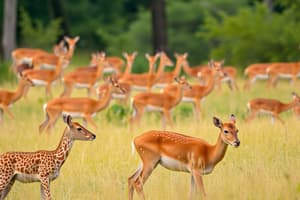Podcast
Questions and Answers
What are the characteristics of populations?
What are the characteristics of populations?
Area of distribution, spatial pattern, density, age structure, sex ratio, survival/mortality rate, birth rate, growth rate.
Define a population.
Define a population.
A group of individuals that belong to the same species, occupy the same physical environment at the same time, and can exchange genes.
What factors affect the distribution of populations?
What factors affect the distribution of populations?
- Abiotic factors (correct)
- Evolutionary history (correct)
- Biotic factors (correct)
- Dispersal (correct)
Which patterns of population movement are there?
Which patterns of population movement are there?
Immigration and emigration refer to movements in both directions.
Immigration and emigration refer to movements in both directions.
What is exponential growth?
What is exponential growth?
Match the population characteristics with their definitions:
Match the population characteristics with their definitions:
Density-independent factors always affect population size.
Density-independent factors always affect population size.
What does the logistic growth model illustrate?
What does the logistic growth model illustrate?
Study Notes
Population - Definition
- A group of individuals belonging to the same species, inhabiting the same physical environment, and capable of interbreeding.
Populations - Characteristics
- Population-level properties:
- Area of distribution
- Spatial pattern
- Density
- Age structure
- Sex ratio
- Survival/ mortality rate
- Birth rate
- Growth rate
Distribution
- Influenced by abiotic and biotic factors, evolutionary history, and dispersal.
- Geographic range differs from distribution within a specific area.
Patterns of Population Movement
- Movement of organisms:
- Animals: Mobile stages
- Plants: Seeds
- Immigration and emigration: Movements in one direction.
- Expansion: Movement from a source.
- Migration: Regular, directional two-way movement influenced by daily or seasonal cycles.
- Expansion: Movement of populations into new regions often introduced by humans.
Expansion (Examples)
- Starlings: Reproduction range (green) and winter locations (points).
- Glacial Retreat: Species expanding into previously uninhabitable areas following glacial retreat.
Migration (Examples)
- Migration occurs when resources are decreasing in one region and abundant in another.
- Plankton: Daily migration.
- Crabs: Migration with tides.
- Birds: Seasonal migration.
- Sockeye Salmon: Migration for spawning.
- Whooping Crane: Migration for breeding.
Spatial Pattern (Dispersion)
- Not all space within a geographic range is suitable due to environmental heterogeneity.
- Random: Individuals with independent spatial positions. Characteristic of a homogenous environment with no attraction or repulsion between individuals.
- Uniform (Regular): Regular spacing of individuals due to intraspecific competition (territoriality) or competition for resources.
- Aggregation: Most common pattern. Influenced by reproduction, dispersal, social behavior, responses to environmental variation, and facilitation in response to conditions.
Population Dynamics
- Changes in population characteristics over time, including size and density.
- Nt = Nt-1 + B - D + I – E
- Nt = Number of individuals at time t
- Nt-1 = Number of individuals at time t-1
- B = Number of births
- D = Number of deaths
- I = Number of immigrants
- E = Number of emigrants
Exponential Growth
- N0 = 1, N1 = 2, N2 = 4, N3 = 8
- Maximum possible growth rate.
- Examples: Bacteria, Gnu populations, Juncus gerardi plants.
Population Growth
- Exponential growth occurs in populations with low density, favorable conditions, and during the initial phase of colonization.
- Continuous exponential growth cannot continue indefinitely, often resulting in population collapse due to famine, disease, or emigration.
- Populations can be regulated by density-dependent factors.
Population Regulating Factors
- Density-independent: Affect populations regardless of density, often abiotic factors like climate (conditions), and destabilize populations.
- Density-dependent: Affect populations in relation to density, often biotic factors like intra- and interspecific competition and predation, and regulate population size.
Logistic Growth
- Sigmoidal curve showing population growth reaching a carrying capacity (K) with time.
- Examples:
- Biomass of bacteria: Gnu, Juncus gerardi plants, Begon, et al., Sigmoidal relationship in population growth reaching a threshold (carrying capacity).
Explanation of the Sigmoidal Curve
- Initially, population grows exponentially.
- As it reaches a certain density, growth rate slows down.
- Carrying capacity (K) is reached when resources are fully used and the population stabilizes.
Exponential vs Logistic Population Growth
- The logistic growth curve approaches K while the exponential growth curve continues to increase indefinitely.
Logistic Growth: Examples
- Tasmanian sheep: Demonstrates the sigmoid (S-shaped) curve of logistic growth.
- Whooping Crane Population: Shows an increase in the population size over time with fluctuations around the carrying capacity.
- Population Dynamics: Changes in population size over time, including continual growth toward K, fluctuations around K, and cycles.
Studying That Suits You
Use AI to generate personalized quizzes and flashcards to suit your learning preferences.
Related Documents
Description
This quiz explores the fundamental definitions and characteristics of populations, including aspects like density, age structure, and patterns of movement. It covers key concepts such as immigration, emigration, and the influences on population distribution. Test your understanding of how populations interact with their environment.





